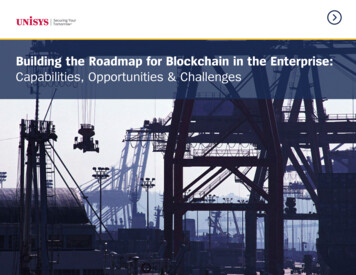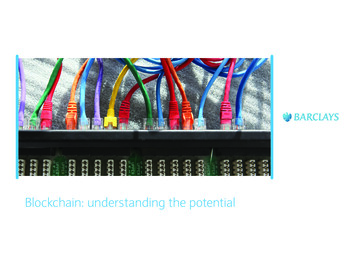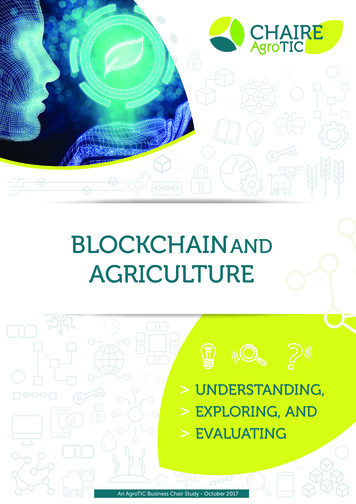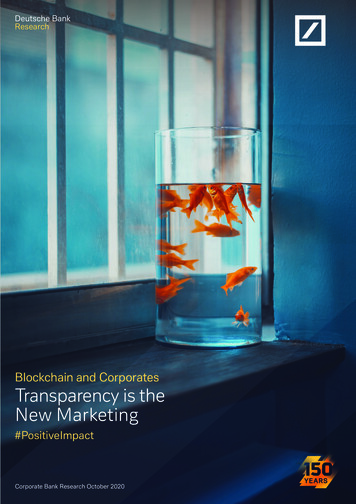
Transcription
Building the Roadmap for Blockchain in the Enterprise:Capabilities, Opportunities & ChallengesBuilding the Roadmap for Blockchain in the Enterprise: Capabilities, Opportunities & Challenges1
One of the most excitingtechnological advances toemerge in a generationIntroductionBlockchain is among the most exciting technological advances to emerge in ageneration — “on the lips of every business leader,” as Gartner says. Yet for allthe attention, blockchain remains a digital phenomenon that is as puzzling as it ispromising — something that’s talked about far more often than it’s understood.Less a technology product than a technology ecosystem, blockchain involvesrecording data and transactions concurrently across a wide digital network — public orprivate — in ways that are transparent, chronological and immutable once recorded.The potential benefits to enterprises from this kind of distributed ledger technology (DLT)can be immense.Unfortunately, reaping those real-world business benefits involves teasing out the valuefrom what’s become — even by tech industry standards — an outsized helping ofhype and mystique. This eBook is a roadmap to leverage blockchain in the real world ofenterprise business — designed to help executives understand blockchain’s promise,pitfalls and potential applications for the organization.Building the Roadmap for Blockchain in the Enterprise: Capabilities, Opportunities & Challenges2
Looking Past Blockchain Headlinesin Search of Enterprise Value“Blockchain” first gained wide notice as a technological approach developed anonymously under the pseudonymSatoshi Nakamoto (to this day, nobody is sure whether Nakamoto is a man, woman or group of people). It’s oftenmentioned in the same breath as bitcoin, since the distributed ledger technology (DLT) that undergirds blockchainhelped solve the double-spending problem around cryptocurrency.In reality, there are different blockchains that are applied to cryptocurrencies and many other novel uses likecrowdfunding and even new forms of journalism. The challenge for the enterprise is to see past these mercurialheadlines and probe for more serious, secure, real-world business applications. The roadmap to enterprise valueinvolves addressing the right permissions, security, interoperability, compliance and a host of other considerationsrequired to implement and optimize a blockchain system in production environments at scale.Building the Roadmap for Blockchain in the Enterprise: Capabilities, Opportunities & Challenges3
Benefits of Distributed Ledger TechnologyLeveraged correctly, blockchain — or, more to the point, the distributed ledger technologyassociated with it — can be hugely valuable for the enterprise in its ability to documentrecords or transactions across wide communities of interest. Distributed ledgertechnology helps lower costs and increase the speed and visibility of transactionsby reducing reliance on a centralized server, database, authority or intermediaries.Private and Permissioned blockchains, which are what businesses typically would use,will still require a certain level of expertise in security to implement a robust and secureblockchain ecosystem. When correctly implemented, blockchain can illuminate a “singlesource of truth” across a wide range of consumers or participants. This is hugely helpfulin situations like emergency response, clinical trials, supply chain and other realms wherediverse inputs feed a collective societal or business goal. Not surprisingly, blockchain isespecially promising for IoT, where it can be used to securely manage the digital identityof IoT devices.Blockchain also enables “smart contracts” — self-executing contracts with the terms ofthe agreement between two or more parties being directly written into lines of code. Indoing so, contract participants can come to a common agreement on what defines asuccessful transaction and then execute when agreed upon metrics are met.These are just a few examples of how blockchain can improve efficiency, visibility,auditability and cost management — but there are several hurdles in the way beforeblockchain can be realized consistently and securely in enterprise settings.Building the Roadmap for Blockchain in the Enterprise: Capabilities, Opportunities & Challenges4
Barriers to Blockchain as Enterprise SolutionsBlockchain is an exciting new technology that unlocks lots of possibilities — but also lotsof potential for misunderstanding, and misapplications from rushed implementations thatdon’t properly address real-world enterprise concerns around security, legacy technology,interoperability, integration and a host of other practical and strategic considerations.Furthermore, the implementation requires reorienting the IT department to graspkey aspects of blockchain-related security, smart contracts law, value exchange anddecentralized governance — all within the context of commercial architectures.There are also cultural barriers that involve getting used to the transparency andunvarnished view into business environments and stakeholder operations. Consider theexample of supply chain example: Two different suppliers can now collaborate to betterunderstand how each other’s priorities differ under a system that allows them both toget the insight they need. This is valuable, but it involves levels of transparency betweencompanies that may take some getting used to.Ultimately, this is still a nascent technology that is growing and changing — one thatmust be harnessed with care before trusting it in the enterprise. And not all of thepotential applications of blockchain will actually become a reality. In the end, it will bethe business value of a use case that will drive adoption.Building the Roadmap for Blockchain in the Enterprise: Capabilities, Opportunities & Challenges5
How Unisys is Getting Blockchain Ready for Prime TimeUnisys is uniquely positioned to pioneer the application of blockchain in the enterprise. We have deep experience with IT infrastructure and understandhow a new technology will impact the business and broader operations at the scale of even the largest global enterprise.As part of this, we’re working to better integrate it into enterprise IT infrastructures and erase the pain points and hurdles to organizational readiness.Much of the to-do list involves creating the right private, permissioned environments for blockchain, like a Hyperledger-Fabric or private Ethereum.We have several focus areas for our efforts: Security is the most important factor. Unfortunately, security is often taken for granted, or as an afterthought. In reality, there are many waysfor security to be compromised around blockchain, including how it’s connected to enterprise systems and how keys can be stolen.Speed is a critical — Transaction rates in public blockchains have traditionally been too slow, on the order of seven transactions per second.Unisys is helping orient enterprises to private DLT environments that can execute much faster, at a thousand or more transactions per second.Keeping up with maturity is a big challenge. As blockchain continues to evolve and shift, Unisys is among the few with the expertise to tracktrends and advances in enterprise-grade implementations to ensure that your blockchain platform remains on the cutting edge and that yourorganization never has to contend with technological obsolescence.On all these fronts, Unisys brings its deep expertise to bear on the blockchain challenge. Both our Zero Trust security architecture — preferred bygovernment and commercial organizations to secure sensitive systems — and our experience in solving the challenges of mission-critical computingare key enablers of a secure deployment of a blockchain technology.Building the Roadmap for Blockchain in the Enterprise: Capabilities, Opportunities & Challenges6
Tips for Enterprises Considering BlockchainWith all this in mind, here are some things any largeenterprise should evaluate when thinking about when,where and how to leverage blockchain — includingpartner considerations:Make sure your approach addresses the entire lifecycleof enterprise implementation and use — You shouldbe able to set up a customized blockchain that is wellintegrated through several stages. As an example:Make sure your partner has expertise not justin blockchain, but also in your specific businessenvironments — In healthcare for instance, it’s hardto trust someone who says “we’re blockchain” but isunfamiliar with HIPPA or other regulatory elements. Thesame is true in other sectors where blockchain may beof use — including customs/border control expertise forglobal supply chain; FDA compliance acumen for Pharma;or deep knowledge of government policy for federalimplementations. Don’t let your initiative introduce yet another layerof complexities or vendor-specific dependencies intoyour existing operation — When implemented properly,blockchain technology enhances your existing platform byremoving silos and replacing intermediaries with a moreefficient and secure peer-to-peer network.Leverage a microservices approach — A microservicesarchitecture will help your blockchain solution be easilyintegrated with other emerging technologies such as AI,biometric security and advanced analytic engines.Building the Roadmap for Blockchain in the Enterprise: Capabilities, Opportunities & Challenges You should be able to quickly set up a proof of conceptfor the purposes of initial testing and evaluating ROI.Wherever ROI is demonstrated, the next step is toengage in an iterative process to implement.You may need to adjust the organizational structureor operational focus of your IT group to align withblockchain systems and processes.There should also be ongoing updates andimprovements to make sure you don’t fall behind asthe technology continues to mature and evolve.7
ConclusionBlockchain has the potential to disrupt countless industries and how organizationsoperate within them. The technology is real and it is being evaluated seriously by manyenterprises and government agencies to enhance and streamline operations. Theseefforts continue and, in many ways, the book is still being written on blockchain inthe enterprise.Unisys has had the unique vantage point of helping write that book through our work invetting and helping optimize its capabilities for enterprise settings. The more we learnabout blockchain — both its promise and how to overcome the pitfalls — the more we’llbe able to continue bringing blockchain-fueled ROI to many more large public andprivate organizations.Building the Roadmap for Blockchain in the Enterprise: Capabilities, Opportunities & Challenges8
Leverage a microservices approach — A microservices architecture will help your blockchain solution be easily integrated with other emerging technologies such as AI, biometric security and advanced analytic engines. Tips for Enterprises Considering Blockchain










